Assessment of Accessibility and Activity Intensity to Identify Future Development Priority TODs in Hefei City
Abstract
:1. Introduction
2. Materials and Methods
2.1. Previous Literature
2.2. Implementation of the Node–Place Model for Hefei City TODs
2.2.1. Catchment Area
2.2.2. Indicator Selection
2.2.3. Data Sources
2.2.4. Reorganization of the Dataset
2.3. Development Priority among the Existing TODs
3. Results and Discussion
4. Conclusions
Author Contributions
Funding
Institutional Review Board Statement
Informed Consent Statement
Data Availability Statement
Conflicts of Interest
References
- Guo, Y.; Qiao, W. Rural migration and urbanization in China: Historical evolution and coupling pattern. Sustainability 2020, 12, 7307. [Google Scholar] [CrossRef]
- Heilig, G.K. World Urbanization Prospects the 2011 Revision; United Nations, Department of Economic and Social Affairs (DESA), Population Division, Population Estimates and Projections Section: New York, NY, USA, 2012. [Google Scholar]
- National Bureau of Statistics of China. 2021. Available online: http://www.stats.gov.cn/enGliSH/Statisticaldata/AnnualData/ (accessed on 11 April 2022).
- Wei, X.; Ren, Y.; Shen, L.; Shu, T. Exploring the spatiotemporal pattern of traffic congestion performance of large cities in China: A real-time data based investigation. Environ. Impact Assess. Rev. 2022, 95, 106808. [Google Scholar] [CrossRef]
- Hua, X.Y.; Cheng, L.; Bai, H. Thinking on application of transit oriented development in Chinese cities. Transp. Stand. 2009, 200, 80–84. [Google Scholar]
- Jen, T.P.; Huang, Y.H. The Travel Behaviours Change of the Residents of Transit Jointed Development in Taipei Metropolitan Area. Int. Rev. Spat. Plan. Sustain. Dev. 2013, 1, 15–23. [Google Scholar]
- Lyu, G.; Bertolini, L.; Pfeffer, K. Developing a TOD typology for Beijing metro station areas. J. Transp. Geogr. 2016, 55, 40–50. [Google Scholar] [CrossRef]
- Ewing, R.; Cervero, R. Travel and the Built Environment: A Meta-Analysis. J. Am. Plan. Assoc. 2010, 76, 265–294. [Google Scholar] [CrossRef]
- Nasri, A.; Zhang, L. The analysis of transit-oriented development (TOD) in Washington, DC and Baltimore metropolitan areas. Transp. Policy 2014, 32, 172–179. [Google Scholar] [CrossRef]
- Wang, D.; Chai, Y. The jobs–housing relationship and commuting in Beijing, China: The legacy of Danwei. J. Transp. Geogr. 2009, 17, 30–38. [Google Scholar] [CrossRef]
- Xu, W.; Guthrie, A.; Fan, Y.; Li, Y. Transit-oriented development in China: Literature review and evaluation of TOD potential across 50 Chinese cities. J. Transp. Land Use 2017, 10, 743–762. [Google Scholar]
- Zhao, W.; Zou, Y. Hefei: An emerging city in inland China. Cities 2018, 77, 158–169. [Google Scholar] [CrossRef]
- CNR News. 2020. Available online: http://www.cnr.cn/ah/jhfc/20200325/t20200325_525029357.shtml (accessed on 23 March 2020).
- Deng, H.; Li, Y.; Li, W.; Yu, Y. Urban transport social needs in China: Quantification with central government transit grant. Transp. Policy 2016, 51, 126–139. [Google Scholar] [CrossRef]
- Su, S.; Zhang, H.; Wang, M.; Weng, M.; Kang, M. Transit-oriented development (TOD) typologies around metro station areas in urban China: A comparative analysis of five typical megacities for planning implications. J. Transp. Geogr. 2021, 90, 102939. [Google Scholar] [CrossRef]
- Higgins, C.D.; Kanaroglou, P.S. A latent class method for classifying and evaluating the performance of station area transit-oriented development in the Toronto region. J. Transp. Geogr. 2016, 52, 61–72. [Google Scholar] [CrossRef]
- Dong, H. Evaluating the impacts of transit-oriented developments (TODs) on household transportation expenditures in California. J. Transp. Geogr. 2021, 90, 102946. [Google Scholar] [CrossRef]
- Li, J.; Huang, H. Effects of transit-oriented development (TOD) on housing prices: A case study in Wuhan, China. Res. Transp. Econ. 2020, 80, 100813. [Google Scholar] [CrossRef]
- Rahman, M.H.; Ashik, F.R.; Mouli, M.J. Investigating spatial accessibility to urban facility outcome of transit-oriented development in Dhaka. Transp. Res. Interdiscip. Perspect. 2022, 14, 100607. [Google Scholar] [CrossRef]
- Chinese Ministry of Housing and Urban-Rural Development. In Guidelines for Planning and Design of Areas along the Urban Rail Transit; Chinese Ministry of Housing and Urban-Rural Development: Beijing, China, 2015.
- Agnihotri, V.; Sahu, S.K.; Roy, S. Potential Assessment of New Metro Station Areas in Lucknow. Int. Res. J. Eng. Technol. (IRJET) 2020, 7, 11–14. [Google Scholar]
- Lee, E.H.; Shin, H.; Cho, S.H.; Kho, S.Y.; Kim, D.K. Evaluating the efficiency of transit-oriented development using network slacks-based data envelopment analysis. Energies 2019, 12, 3609. [Google Scholar] [CrossRef]
- Kalyuzhnyi, N.; Losin, L. A method of mathematical modeling for transfer hub establishment in Saint Petersburg. Transp. Res. Procedia 2018, 36, 245–251. [Google Scholar] [CrossRef]
- He, D. Urban Transport of China Failure and Improvement of 3D Principle in Transit-Oriented Development in China: Retrospection on Development along Subway Line 1 in Guangzhou. Urban Transp. China 2018, 2018, 47–53. [Google Scholar]
- Bertolini, L. Spatial development patterns and public transport: The application of an analytical model in the Netherlands. Plan. Pract. Res. 1999, 14, 199–210. [Google Scholar] [CrossRef]
- Chorus, P.; Bertolini, L. An application of the node place model to explore the spatial development dynamics of station areas in Tokyo. J. Transp. Land Use 2011, 4, 45–58. [Google Scholar]
- Reusser, D.E.; Loukopoulos, P.; Stauffacher, M.; Scholz, R.W. Classifying Railway Stations for Sustainable Transitions—Balancing Node and Place Functions. J. Transp. Geogr. 2008, 16, 191–202. [Google Scholar] [CrossRef]
- Kamruzzaman, M.; Baker, D.; Washington, S.; Turrell, G. Advance transit oriented development typology: Case study in Brisbane, Australia. J. Transp. Geogr. 2014, 34, 54–70. [Google Scholar] [CrossRef]
- Monajem, S.; Ekram Nosratian, F. The evaluation of the spatial integration of station areas via the node place model; an application to subway station areas in Tehran. Transp. Res. Part D Transp. Environ. 2015, 40, 14–27. [Google Scholar] [CrossRef]
- Zhang, Y.; Marshall, S.; Manley, E. Network criticality and the node-place-design model: Classifying metro station areas in Greater London. J. Transp. Geogr. 2019, 79, 102485. [Google Scholar] [CrossRef]
- Vale, D.S.; Viana, C.M.; Pereira, M. The extended node-place model at the local scale: Evaluating the integration of land use and transport for Lisbon’s subway network. J. Transp. Geogr. 2018, 69, 282–293. [Google Scholar] [CrossRef]
- Rousseeuw, P.J. Silhouettes: A graphical aid to the interpretation and validation of cluster analysis. J. Comput. Appl. Math. 1987, 20, 53–65. [Google Scholar] [CrossRef]
- Singh, Y.J.; Fard, P.; Zuidgeest, M.; Brussel, M.; van Maarseveen, M. Measuring transit oriented development: A spatial multi criteria assessment approach for the City Region Arnhem and Nijmegen. J. Transp. Geogr. 2014, 35, 130–143. [Google Scholar] [CrossRef]
- Li, Z.; Han, Z.; Xin, J.; Luo, X.; Su, S.; Weng, M. Transit oriented development among metro station areas in Shanghai, China: Variations, typology, optimization and implications for land use planning. Land Use Policy 2019, 82, 269–282. [Google Scholar] [CrossRef]
- Zemp, S.; Stauffacher, M.; Lang, D.J.; Scholz, R.W. Classifying railway stations for strategic transport and land use planning: Context matters! J. Transp. Geogr. 2011, 19, 670–679. [Google Scholar] [CrossRef]
- Vale, D.S. Transit-oriented development, integration of land use and transport, and pedestrian accessibility: Combining node-place model with pedestrian shed ratio to evaluate and classify station areas in Lisbon. J. Transp. Geogr. 2015, 45, 70–80. [Google Scholar] [CrossRef]
- Liang, Y.; Du, M.; Wang, X.; Xu, X. Planning for urban life: A new approach of sustainable land use plan based on transit-oriented development. Eval. Program Plan. 2020, 80, 101811. [Google Scholar] [CrossRef]
- Dou, M.; Wang, Y.; Dong, S. Integrating Network Centrality and Node-Place Model to Evaluate and Classify Station Areas in Shanghai. ISPRS Int. J. Geo-Inf. 2021, 10, 414. [Google Scholar] [CrossRef]
- Hefei Bus Guide App. Available online: http://hefei.gongjiao.com/ (accessed on 20 May 2021).
- The Website of Metro Operational Map. Available online: http://www.hfgdjt.com/ (accessed on 10 June 2021).
- The OpenStreetMap Website. Available online: https://www.openstreetmap.org/#map=6/31.504/122.058 (accessed on 21 December 2021).
- Berawi, M.A.; Saroji, G.; Iskandar, F.A.; Ibrahim, B.E.; Miraj, P.; Sari, M. Optimizing land use allocation of Transit-Oriented Development (TOD) to generate maximum ridership. Sustainability 2020, 12, 3798. [Google Scholar] [CrossRef]
- Cervero, R.; Kockelman, K. Travel demand and the 3Ds: Density, diversity, and design. Transp. Res. Part D Transp. Environ. 1997, 2, 199–219. [Google Scholar] [CrossRef]
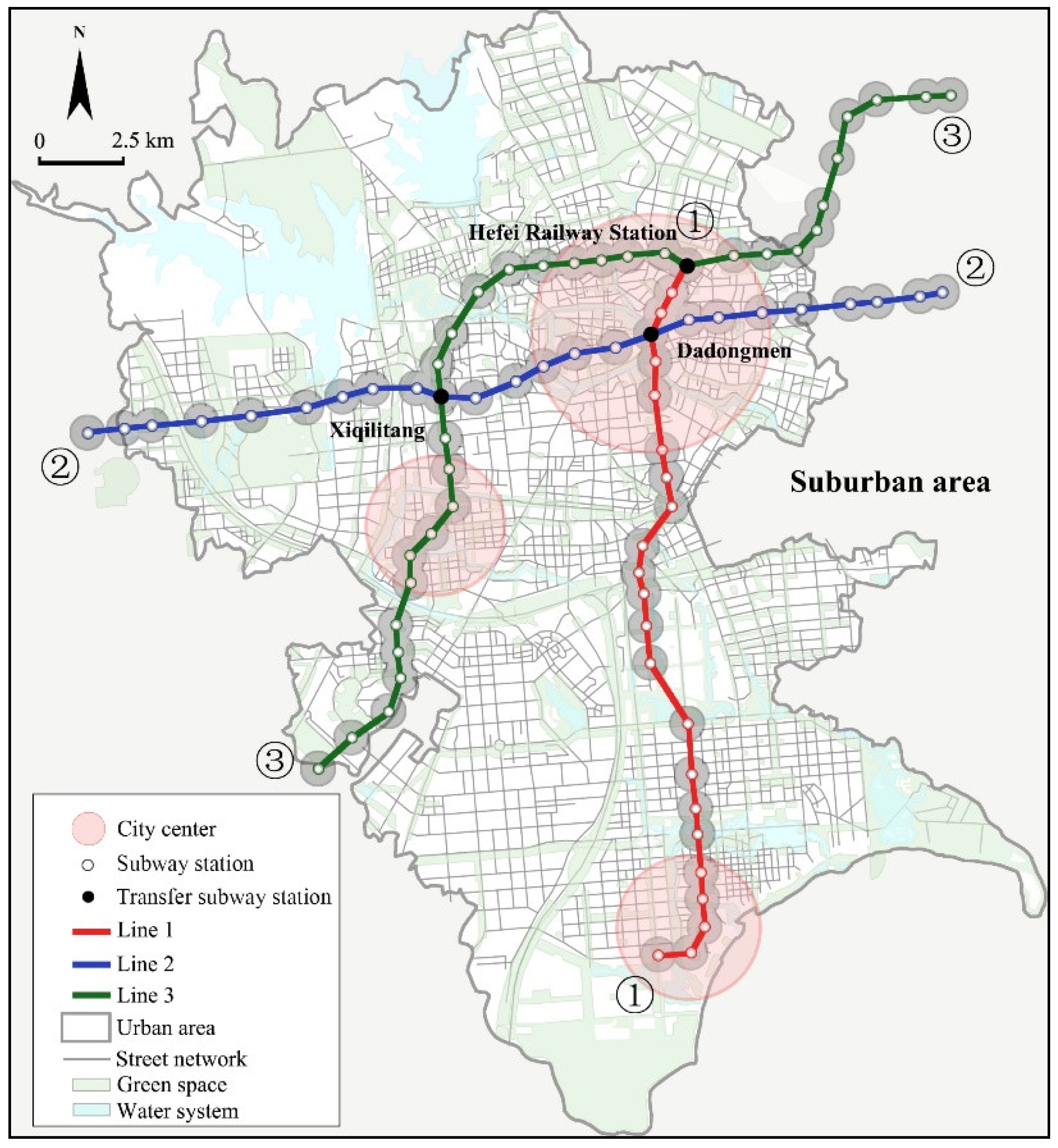

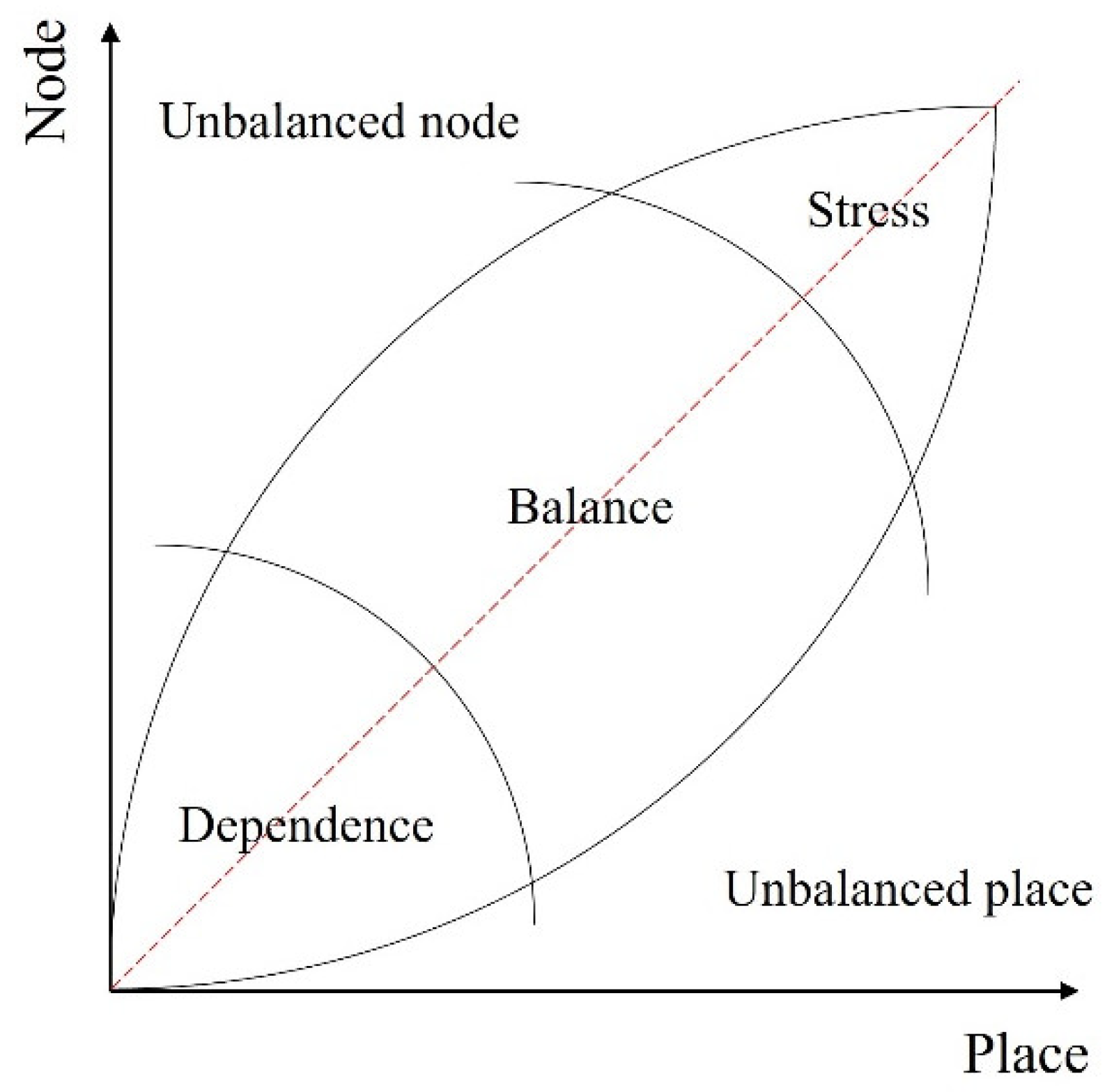

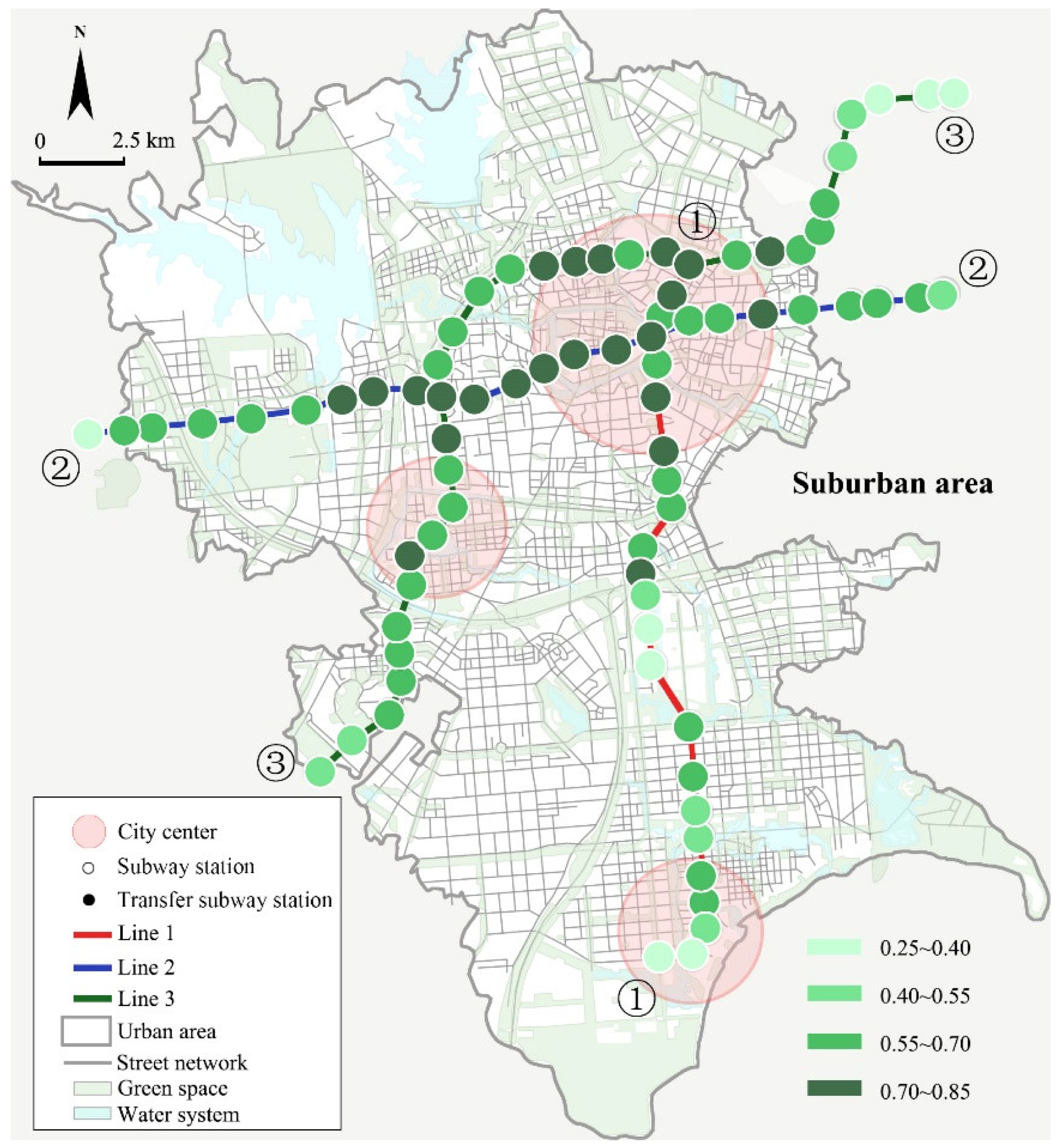
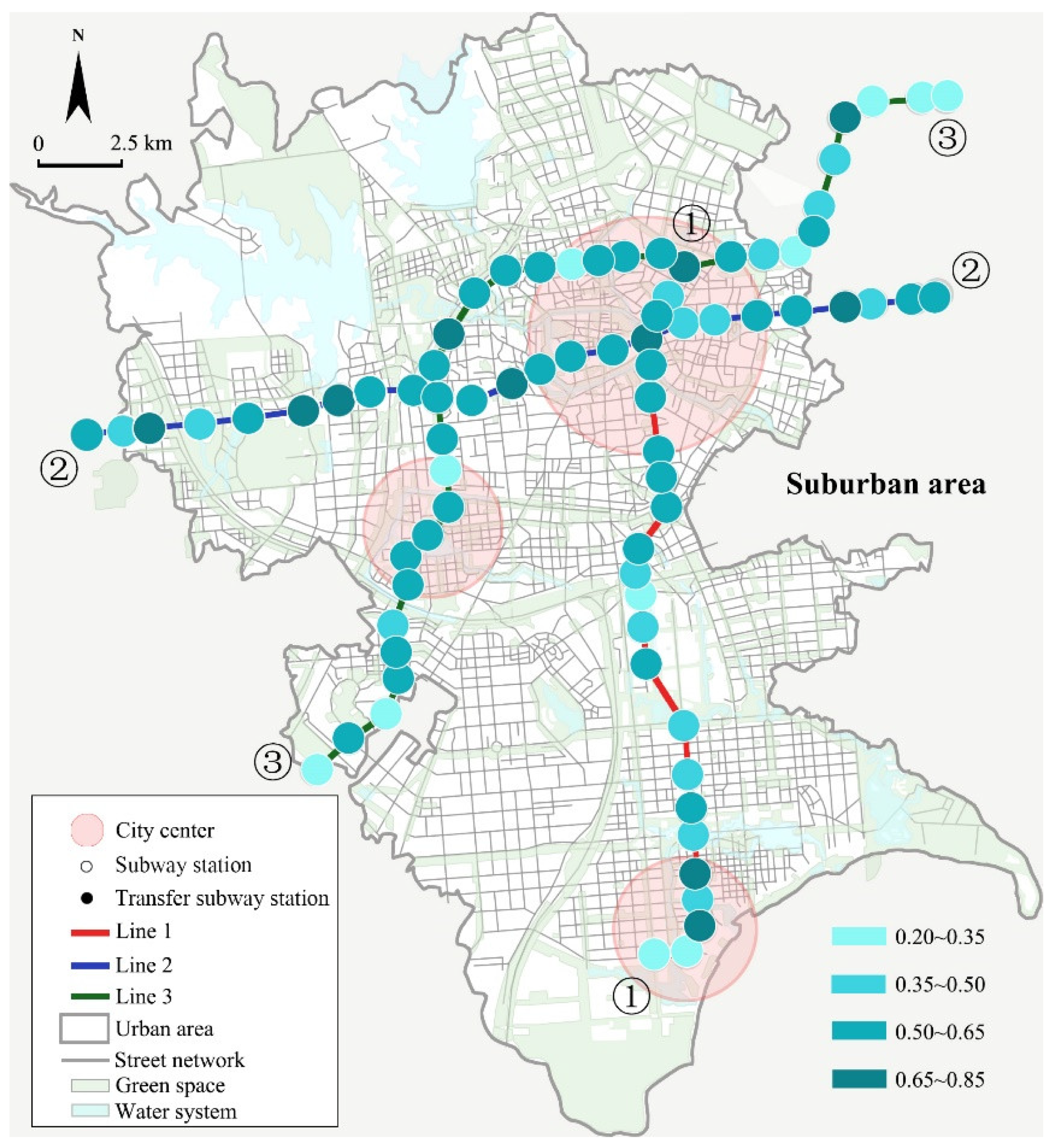
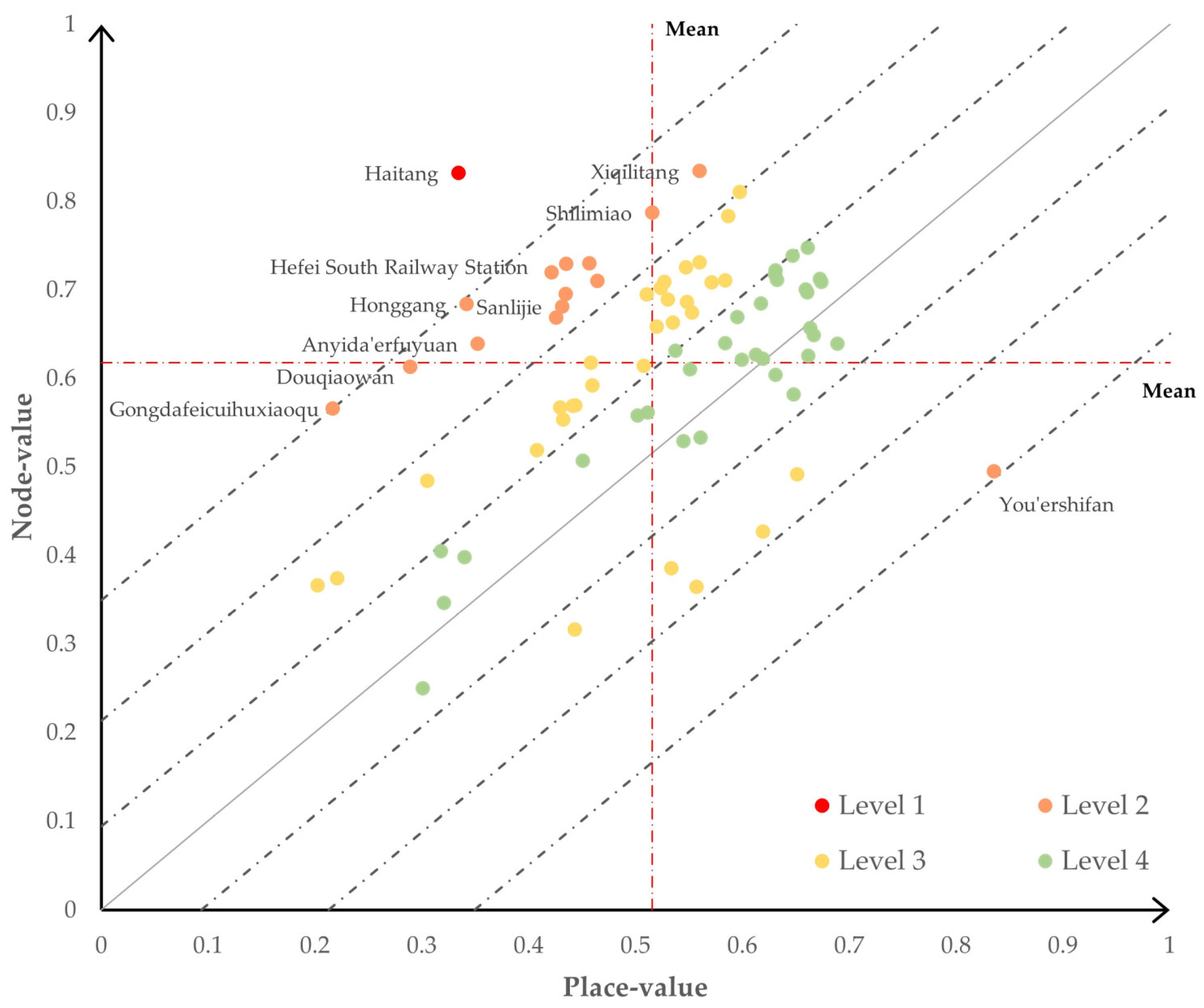
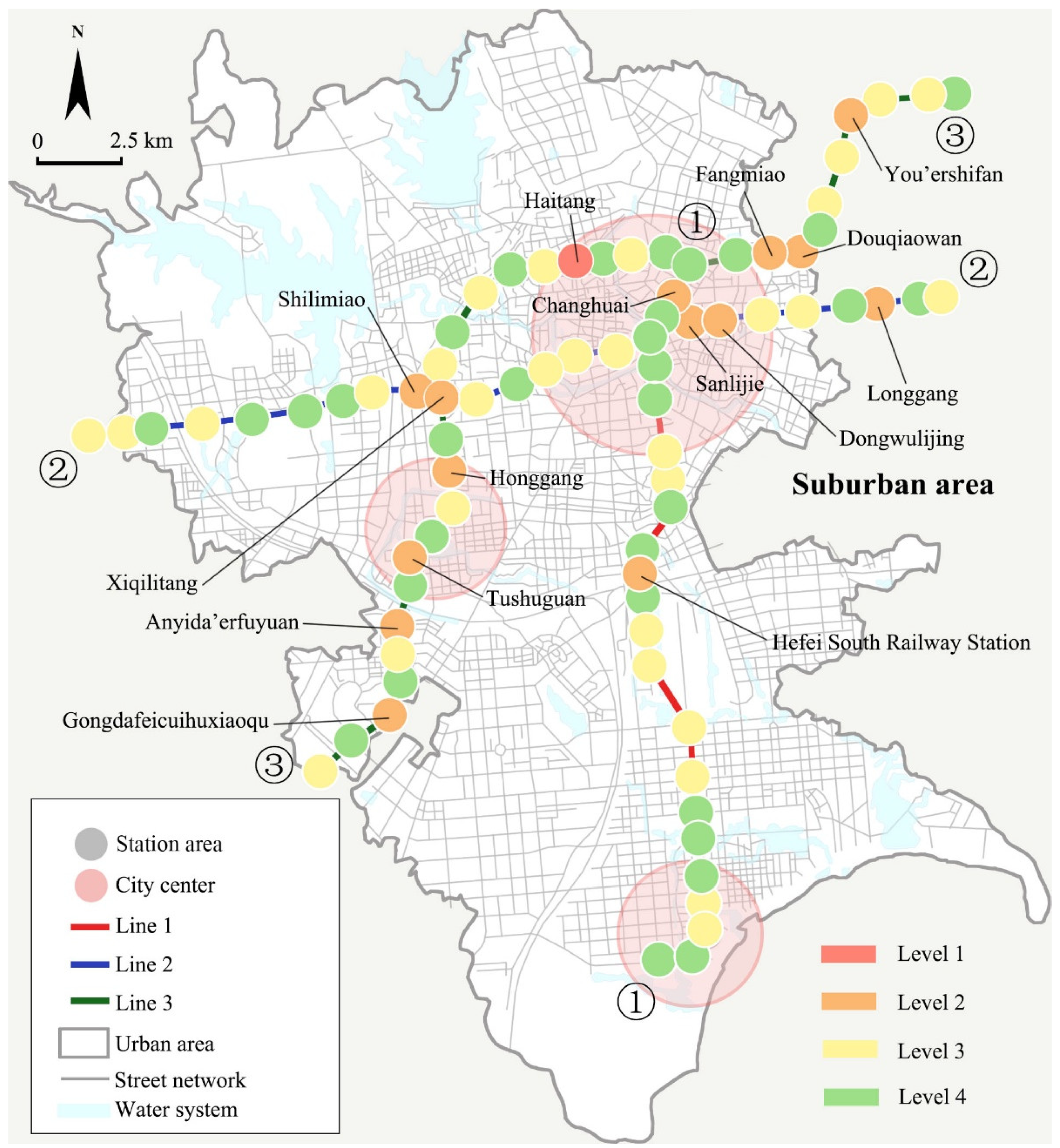
| Values | Indicators | |
|---|---|---|
| Node-value | Accessibility by train | Number of directions served |
Place-value | Accessibility by bus, tram, and underground Accessibility by car Accessibility by bicycle | Daily frequency of services Number of stations within 45 min of travel Number of directions Daily frequency Distance from the closest motorway access Parking capacity Number of free-standing bicycle paths Parking capacity Number of residents in the area Number of workers per each of four economic clusters (retail/hotel and catering, education/health/culture, administration and services, industry and distribution) Degree of functional mix |
| Indicators | Measurement | Data Source |
|---|---|---|
| Number of directions served by Metro (y1) | Number of subway services offered at the station from Hefei Metro Operational Map | The website of Metro Operational Map. http://www.hfgdjt.com/ (accessed on 10 June 2021) |
| Daily frequency of Metro services (y2) | Number of subways departing from the station on a working day from Hefei Metro Operational Map | The website of Metro Operational Map. http://www.hfgdjt.com/ (accessed on 10 June 2021) |
| Number of stations within 20 min of travel (y3) | Number of stations reachable within 20 min by subway from Hefei Metro Operational Map | The website of Metro Operational Map. http://www.hfgdjt.com/ (accessed on 10 June 2021) |
| Travel time to the CBD (seconds) (y4) | The travel time to the CBD by subway from Hefei Metro Operational Map | The website of Metro Operational Map. http://www.hfgdjt.com/ (accessed on 10 June 2021) |
| Number of directions served by buses (y5) | Number of bus services offered at the station from Hefei Bus Guide App | Hefei Bus Guide App. http://hefei.gongjiao.com/ (accessed on 20 May 2021) |
| Daily frequency of bus services (y6) | Number of buses departing from the station on a working day from Hefei Bus Guide App | Hefei Bus Guide App. http://hefei.gongjiao.com/ (accessed on 20 May 2021) |
| Distance from the closest motorway access (y7) | Distance to next highway exit | The OpenStreetMap website. https://www.openstreetmap.org/#map=6/31.504/122.058 (accessed on 21 December 2021) |
| Car parking capacity (y8) | The area of car parking within 500 m walking distance from metro stations | The OpenStreetMap website. https://www.openstreetmap.org/#map=6/31.504/122.058 (accessed on 21 December 2021) |
| Residential land (x1) | The area of residential land within 500 m walking distance from metro stations (D1) | The OpenStreetMap website. https://www.openstreetmap.org/#map=6/31.504/122.058 (accessed on 21 December 2021) |
| Retail, hotel, and catering land (x2) | The area of commercial land within 500 m walking distance from metro stations (D2) | The OpenStreetMap website. https://www.openstreetmap.org/#map=6/31.504/122.058 (accessed on 21 December 2021) |
| Parks, forest (x3) | The area of parks, forest within 500 m walking distance from metro stations (D3) | The OpenStreetMap website. https://www.openstreetmap.org/#map=6/31.504/122.058 (accessed on 21 December 2021) |
| Industrial and distribution land (x4) | The area of industrial and distribution within 500 m walking distance from metro stations (D4) | The OpenStreetMap website. https://www.openstreetmap.org/#map=6/31.504/122.058 (accessed on 21 December 2021) |
| Education, health, culture land (x5) | The area of cultural, education, health land within 500 m walking distance from metro stations (D5) | The OpenStreetMap website. https://www.openstreetmap.org/#map=6/31.504/122.058 (accessed on 21 December 2021) |
| Service and administration land (x6) | The area of public service land within 500 m walking distance from metro stations (D6) | The OpenStreetMap website. https://www.openstreetmap.org/#map=6/31.504/122.058 (accessed on 21 December 2021) |
| Degree of functional mix (x7) | Land function mix a = max (D1 D2 D3 D4 D5 D6) | |
| b = min (D1 D2 D3 D4 D5 D6) | ||
| c = (D1 + D2 + D3 + D4 + D5 + D6)/6 | ||
| d = D1 + D2 + D3 + D4 + D5 + D6 | ||
| F = 1 − ((a − b)/d − (a − c)/d)/2 |
| (a) | |||||||||
|---|---|---|---|---|---|---|---|---|---|
| Level | TOD Name | Metro Directions | Metro Frequency | Stations within 20 min | Travel Time to CBD | Bus Directions | Bus Frequency | Distance to Motorway Access | Car Parking Capacity |
| L1 (N = 1) | Haitang | 0.5 | 0.0353 | 0.6263 | 0.7255 | 1 | 0.8695 | 0.8602 | 0.9515 |
| L2 (N = 14) | Douqiaowan | 0.5 | 0.0353 | 0.5096 | 0.6831 | 0.5372 | 0.7341 | 0.8177 | 0.5981 |
| You’ershifan | 0.5 | 0.0353 | 0.164 | 0.633 | 0.6496 | 0.6348 | 0.8541 | 0 | |
| Changhuai | 0.5 | 0.1307 | 0.8645 | 0.3811 | 0.7335 | 0.8955 | 0.7973 | 0.9234 | |
| Sanlijie | 0.5 | 0.0000 | 0.9048 | 0.1906 | 0.9829 | 0.7237 | 0.7639 | 0.8834 | |
| Anyida’erfuyuan | 0.5 | 0.0353 | 0.2912 | 0.8957 | 0.8004 | 0.8148 | 0.3484 | 0.9379 | |
| Dongwulijing | 0.5 | 0.0000 | 0.8504 | 0.3811 | 0.8562 | 0.8709 | 0.7701 | 0.836 | |
| Fangmiao | 0.5 | 0.0353 | 0.806 | 0.633 | 0.5372 | 0.7341 | 0.8192 | 0.6854 | |
| Gongdafeicuihuxiaoqu | 0.5 | 0.0353 | 0.0601 | 0.9528 | 0.5981 | 0.7341 | 0.5614 | 0.5981 | |
| Hefei South Railway Station | 0.5 | 0.1307 | 0.7578 | 0.7255 | 0.8809 | 0.9641 | 0.0000 | 0.5054 | |
| Honggang | 0.5 | 0.0353 | 0.6671 | 0.7622 | 0.7686 | 0.7126 | 0.5865 | 0.9515 | |
| Longgang | 0.5 | 0.0000 | 0.6048 | 0.6831 | 0.7335 | 0.7595 | 0.7039 | 0.8655 | |
| Shilimiao | 0.5 | 0.0000 | 0.9889 | 0.7255 | 0.9255 | 0.8316 | 0.8258 | 1.0000 | |
| Tushuguan | 0.5 | 0.0353 | 0.4831 | 0.8498 | 0.7686 | 0.8195 | 0.2878 | 0.9234 | |
| Xiqilitang | 1 | 0.9339 | 0.8782 | 0.633 | 1.0000 | 0.9048 | 0.6981 | 0.9448 | |
| Mean (N = 77) | 0.4908 | 0.0877 | 0.542 | 0.7079 | 0.5903 | 0.7128 | 0.6821 | 0.6614 | |
| (b) | |||||||||
| Level | TOD Name | Residential | Retail Catering | Parks Forest | Industrial | Educational Health Culture | Service | Degree of Functional Mix | |
| L1 (N = 1) | Haitang | 0.7755 | 0.7233 | 0.0000 | 0.8402 | 0.0000 | 0.0000 | 0.9 | |
| L2 (N = 14) | Douqiaowan | 0.7716 | 0.0000 | 0.000 | 0.0000 | 0.7075 | 0.0000 | 0.9167 | |
| You’ershifan | 0.712 | 0.7177 | 0.868 | 0.7959 | 0.9824 | 0.7705 | 0.9306 | ||
| Changhuai | 0.9073 | 0.9479 | 0.0000 | 0.0000 | 0.8516 | 0.0000 | 0.9167 | ||
| Sanlijie | 0.7909 | 0.7932 | 0.0000 | 0.0000 | 0.9216 | 0.0000 | 0.9167 | ||
| Anyida’erfuyuan | 0.712 | 0.7177 | 0.868 | 0.7959 | 0.9824 | 0.7705 | 0.9306 | ||
| Dongwulijing | 0.7798 | 0.8578 | 0.0000 | 0.0000 | 0.8618 | 0.0000 | 0.9167 | ||
| Fangmiao | 0.7496 | 0.7656 | 0.7972 | 0.8851 | 0.0000 | 0.0000 | 0.9167 | ||
| Gongdafeicuihuxiaoqu | 0.0000 | 0.0000 | 0.0000 | 0.0000 | 0.9725 | 0.0000 | 0.9167 | ||
| Hefei South Railway Station | 0.0000 | 0.7421 | 0.0000 | 0.7971 | 0.0000 | 0.9638 | 0.9167 | ||
| Honggang | 0.7936 | 0.8013 | 0.0000 | 0.7965 | 0.0000 | 0.0000 | 0.9 | ||
| Longgang | 0.8029 | 0.8138 | 0.0000 | 0.0000 | 0.82 | 0.0000 | 0.9167 | ||
| Shilimiao | 0.9517 | 0.871 | 0.0000 | 0.8074 | 0.4351 | 0.0000 | 0.9167 | ||
| Tushuguan | 0.6607 | 0.8248 | 0.0000 | 0.9214 | 0.0000 | 0.0000 | 0.9167 | ||
| Xiqilitang | 0.9394 | 0.9129 | 0.0000 | 0.0000 | 0.9167 | 0.607 | 0.9167 | ||
| Mean (N = 77) | 0.7657 | 0.6728 | 0.1915 | 0.5001 | 0.6506 | 0.3345 | 0.9159 | ||
Publisher’s Note: MDPI stays neutral with regard to jurisdictional claims in published maps and institutional affiliations. |
© 2022 by the authors. Licensee MDPI, Basel, Switzerland. This article is an open access article distributed under the terms and conditions of the Creative Commons Attribution (CC BY) license (https://creativecommons.org/licenses/by/4.0/).
Share and Cite
Wu, W.; Divigalpitiya, P. Assessment of Accessibility and Activity Intensity to Identify Future Development Priority TODs in Hefei City. Land 2022, 11, 1590. https://doi.org/10.3390/land11091590
Wu W, Divigalpitiya P. Assessment of Accessibility and Activity Intensity to Identify Future Development Priority TODs in Hefei City. Land. 2022; 11(9):1590. https://doi.org/10.3390/land11091590
Chicago/Turabian StyleWu, Wei, and Prasanna Divigalpitiya. 2022. "Assessment of Accessibility and Activity Intensity to Identify Future Development Priority TODs in Hefei City" Land 11, no. 9: 1590. https://doi.org/10.3390/land11091590
APA StyleWu, W., & Divigalpitiya, P. (2022). Assessment of Accessibility and Activity Intensity to Identify Future Development Priority TODs in Hefei City. Land, 11(9), 1590. https://doi.org/10.3390/land11091590






